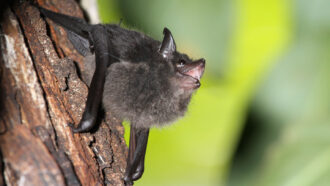
At least 65 million years of evolution separate humans and greater sac-winged bats, but these two mammals share a key feature of learning how to speak: babbling.
Just as human infants babble their way from “da-da-da-da” to “Dad,” wild bat pups (Saccopteryx bilineata) learn the mating and territorial songs of adults by first babbling out the fundamental syllables of the vocalizations, researchers report in the Aug. 20 Science. These bats now join humans as the only clear examples of mammals who learn to make complex vocalizations through babbling.
“This is a hugely important step forward in the study of vocal learning,” says Tecumseh Fitch, an evolutionary biologist at the University of Vienna not involved in the new study. “These findings suggest that there are deep parallels between how humans and young bats learn to control their vocal apparatus,” he says. The work could enable future studies that might allow researchers to peer deeper into the brain activity that underpins vocal learning.
Before complex vocalizations, whether words or mating songs, can be spoken or sung, vocalizers must learn to articulate the syllables that make up a species’s vocabulary, says Ahana Fernandez, an animal behavior biologist at the Museum für Naturkunde in Berlin. “Babbling is a way of practicing,” and honing those vocalizations, she says.
The rhythmic, repetitive “ba-ba-ba’s” and “ga-ga-ga’s” of human infants may sound like gibberish, but they are necessary exploratory steps toward learning how to talk. Seeing whether babbling is required for any animal that learns complex vocalizations necessitates looking in other species.
Many songbirds babble to learn their songs. Some marmosets babble too (SN: 8/13/15), but only to solicit care, for example, not to learn a complex vocal repertoire, Fernandez says. Another mammal, the greater sac-winged bat, had been heard making babbling-like sounds in 2006. Males of this highly social species combine 25 different syllable types into songs used to defend territories and attract mates, but the babbling behavior wasn’t formally studied. Fernandez sought to change that by getting up close and personal with the bats.
At bat colonies in Panama and Costa Rica, Fernandez spent a couple of weeks before pups were born slowly inching closer to the adult animals, habituating them to her presence. By the time the pups arrived and started babbling, she could spend all day camped just meters from the bats. She observed and recorded the sounds of 20 pups over three months as the bats developed their vocal repertoire by imitating male tutors. All told, she and her colleagues captured and analyzed 55,056 syllables from 216 bouts of babbling.
Overall, “bat pup babbling is defined by the same characteristics as human infant babbling,” Fernandez says. Like humans and other babblers, the behavior started early in development, a little over two weeks after the bats’ birth. Protosyllables (akin to human “ba’s” or “ga’s”) were the most prevalent sound made and exhibited lots of variability. These seemingly playful experimentations might help pups shape their vocalizations to match adults, Fernandez explains. Syllables were repeated and were rhythmic, both common features of babbling.
Like humans, both male and female pups babbled, even though female bats don’t sing as adults. That is vastly different from most songbirds, where only the males are known to babble and sing.
“Females might use [their babbling experience] as a template” for making mating decisions as adults about which bats are better singers, Fernandez says.
The bats may not babble exactly like other known babblers, says Pralle Kriengwatana, a behavioral biologist at the University of Glasgow in Scotland who wasn’t involved in the study. Compared with some songbirds, “this ability to produce adultlike syllables seems to happen much quicker in bats,” she says, noting an abrupt rise in the number of adultlike syllables early in babbling. That rapid expansion might mean that practice through babbling is less important for certain bat syllables than growing the neurological and physiological capacity through normal development, she says.
“Obviously, the bats are babbling,” says Ofer Tchernichovski, an ethologist at the City University of New York’s Hunter College. He hopes the babbling behavior will be confirmed in a more controlled laboratory setting, and, more generally, he says he’s glad to have another animal through which to study vocal learning. “Songbirds are nice, but they’re very far from us.” By investigating another mammal, this research “opens the door,” he says, for studying the neural underpinnings of language’s fundamental building blocks.


